| Photojournal
- 18 December
2005
Avocet
at The Serp
|
On Sunday the 18th,
the weather was nice, and I went down to Mud Bay in south Surrey
to try to find a shorebird that I'd never seen before, an American
Avocet. This particular bird has been a regular visitor to this
area over the last few years, but I hadn't heard about it until
my friend Carlo mentioned seeing it in the week before. Mud Bay
is not one of my real regular haunts; I'd only been there a couple
of times before.
The bird's favorite
place is not in Mud Bay park proper, but rather on the other side
of a rail trestle in the mouth of the Serpentine River, or The
Serp (as Carlo calls it). I walked across the tracks and up
onto a dyke that runs along the river bank. On the dyke, I was
treated to a view of a few thousand ducks and shorebirds gathered
in the direct sunlight. There were birds everywhere on the water
and on the shore. I instantly thought "how am I going to
find one shorebird that I've never seen before in the midst of
this crowd?" Shorebirds, like sandpipers, dowitchers, and
godwits, are notoriiously difficult birds to identify. Avocets
were supposed to be fairly distinctive—a large white shorebird
with black-and-white wings and an upturned bill—but even
well-marked shorebirds have this nasty habit of hunkering down
and tucking their bill under their wing, making identification
difficult.
Anyhow, I resigned
myself to my task of looking through all of these birds for my
target, and I took another glance at the mob, whereupon one bird
in the middle distance stood out like a sore thumb. It was a big
whitish bird that was about duck-sized, but was clearly walking
through the water rather than floating on it. It was also moving
about three times as fast as the other birds out there, moving
its bill and head around in a quick but rather shorebird-ish way.
It was a shorebird on speed. It was the avocet.
I watched him through
my binoculars for a while, and then set up my tripod and camera.
He was at about the end of camera range, but I still got very
clearly identifiable photos. In this first one, you can see the
way his bill curls upward at the end.
|
|
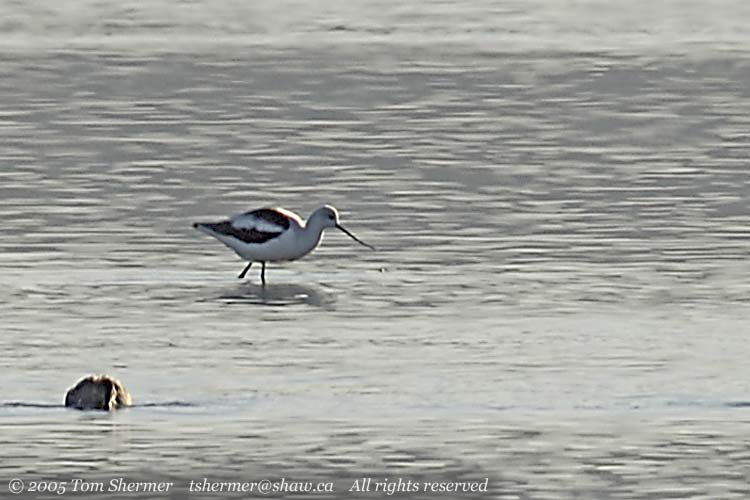 |
| That other
lump in the photo is a dabbling duck of some sort, with its head
down in the water. Here's a shot I caught where the avocet had its
bill open. |
|
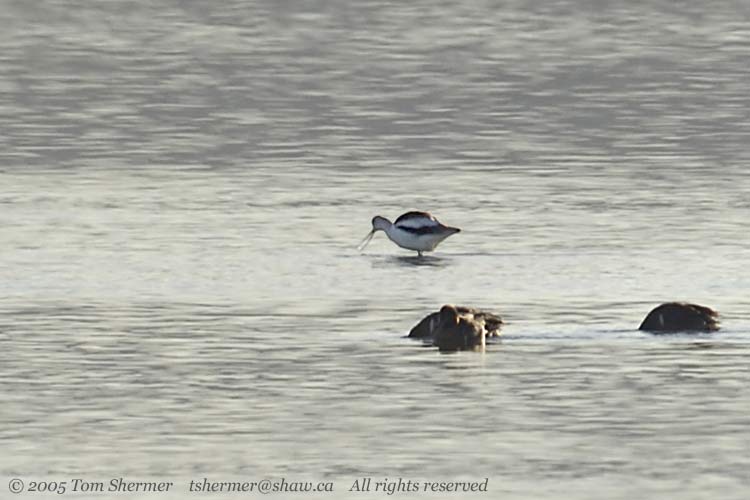 |
|
I waited around for
him to come closer so that I could get better shots, but he never
did. Eventually he flew over to the other side of the trestle,
where I was unable to relocate him.
While I waited for
the avocet to come closer, I took a few shots of some of the other
birds that were there, like this Green-winged Teal. The Green-winged
Teal has a green speculum, or colored patch on the wings.
Interestingly enough, that speculum turns blue in the right kind
of lighting, as I captured in this photo. The lighting also turned
this guy's head patch from green to blue-black.
|
|
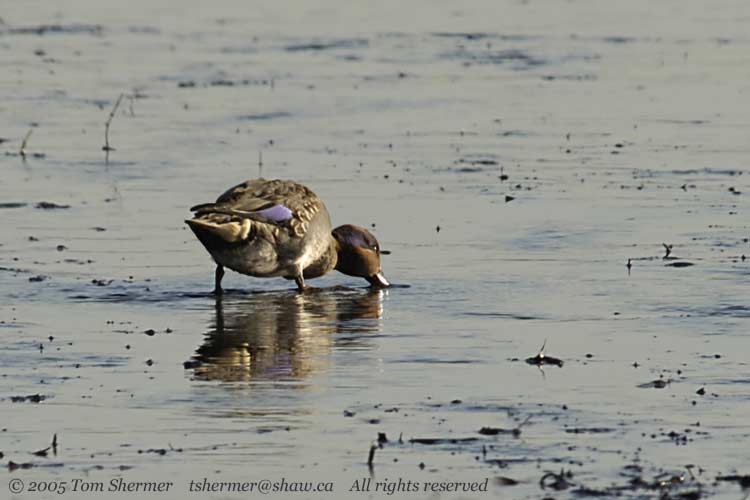 |
| There were
also a bunch of Dunlin poking around in the mud. |
|
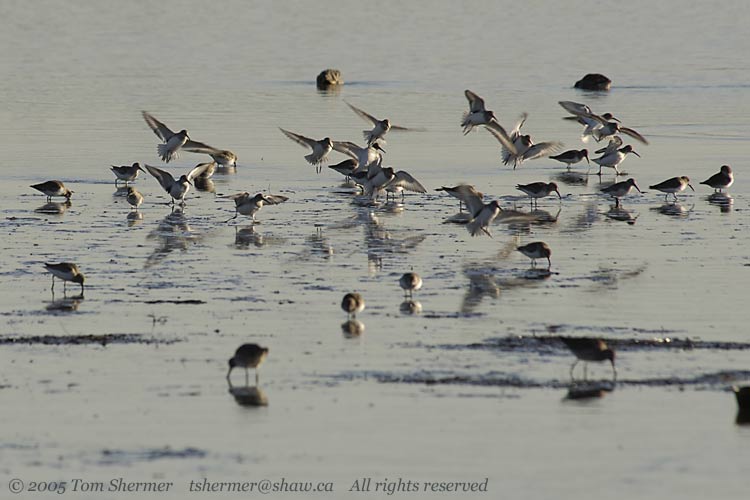 |
| As I headed
back towards the trestle to see if I could relocate the American
Avocet, a Red-tailed Hawk flew by, headed south towards White Rock
and Crescent Beach. |
|
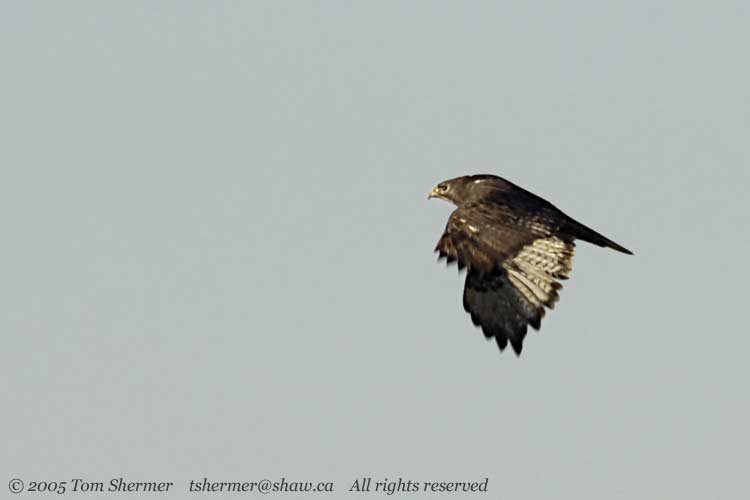 |
|
And soon thereafter,
a Bald Eagle passed almost right overhead, heading the other way.
Baldies have about six fairly distinctive plumages, for juveniles,
one- through four-year-olds, and adult birds. This one is, a three-year-old,
but it appears to have had a slow molt, meaning that it didn't
replace as many feathers in the last year as the average eagle
does. This has left it with a ragged trailing edge to its wing,
caused by the longer (older) feathers alongside the shorter (newer)
ones.
|
|
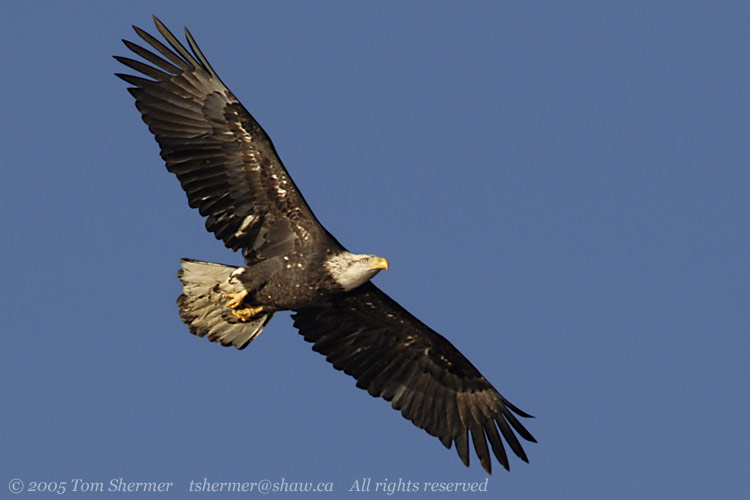 |
|
I recently acquired
a book with a lot of detail on raptor molting patterns, so I could
go on into a lot more detail about eagle molting, but I'm sure
you'd rather I just get on with the pictures rather than give
a detailed ornithology lesson.
I crossed the rail
tracks by going under the trestle, but as I said earlier, I wasn't
able to relocate the Avocet once I did. I circumnavigatied a fence
by crawling on some beach rocks and thereby made it back to the
grounds of Mud Bay Park. In the bay there were only a few birds,
mostly dabbling ducks and a few Greater Yellowlegs, like this
fellow.
|
|
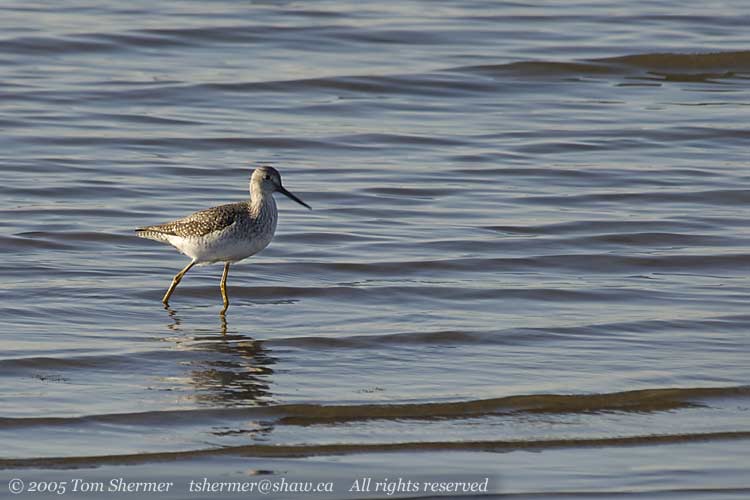 |
| I was walking
fairly leisurely, just enjoying the weather and that warm fuzzy
feeling that comes from having found one's target bird. I eventually
came to a place where some sort of berry bushes grew by the trail,
and noticed some sparrows zipping around in them. I patiently waited
at a couple of spots before I was able to catch one being still
long enough for me to get a decent photo. The sparrows were Golden-crowned
Sparrows, and this one's a juvenile. |
|
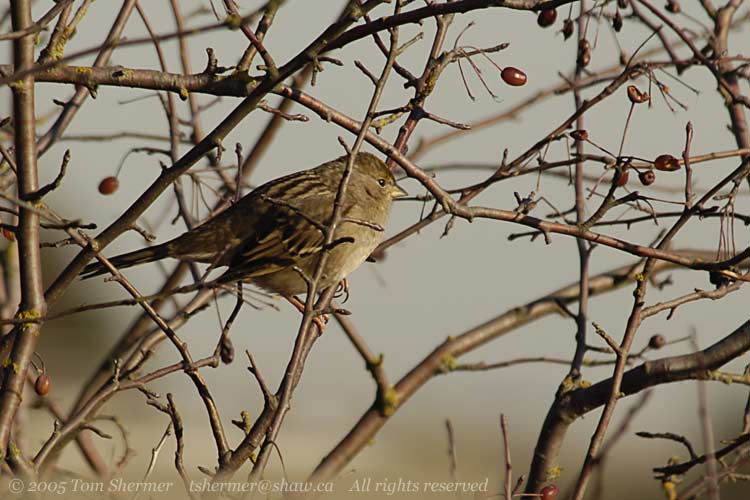 |
| Back on
the bay, I did find one more interesting bird...a female Common
Goldeneye. The sloped head and mainly black bill distinguish her
from the similar Barrow's Goldeneye. |
|
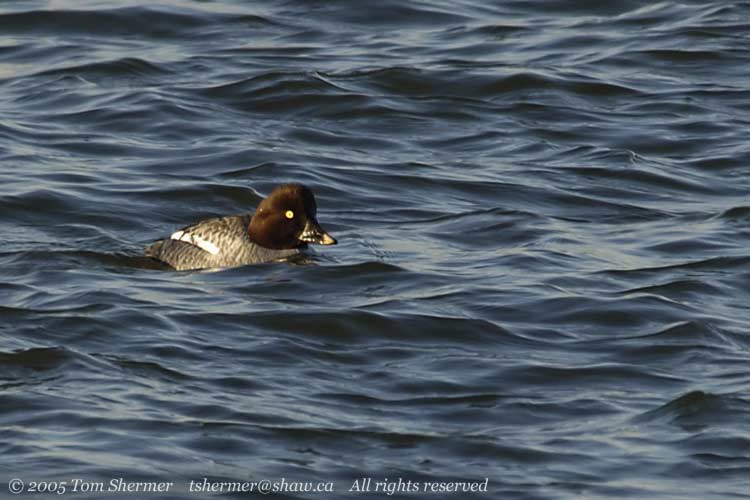 |
|
After this, I reached
a place where I had to choose between heading back towards my
car or heading away from it (I had been, roughly, circling it)
and I headed back to the car, despite a good adult-Bald-Eagle-perched-in-a-tree
opportunity the other direction. It was getting to be eagle-in-tree
season, anyhow, and I'd already had a nice, close, eagle fly-by.
Besides which, I wanted to go see some Snowy Owls, and the days
are awful short this time of year.
Once in my car, I headed
across Delta and Ladner to Brunswick Point, partly just to find
Snowies in a location other than at the foot of 72nd Street. I
walked along the path at Brunswick, and saw a few Northern Harriers
out hunting over the foreshore. None of them came close enough
for a good portrait, but they did present some nice silhouettes.
|
|
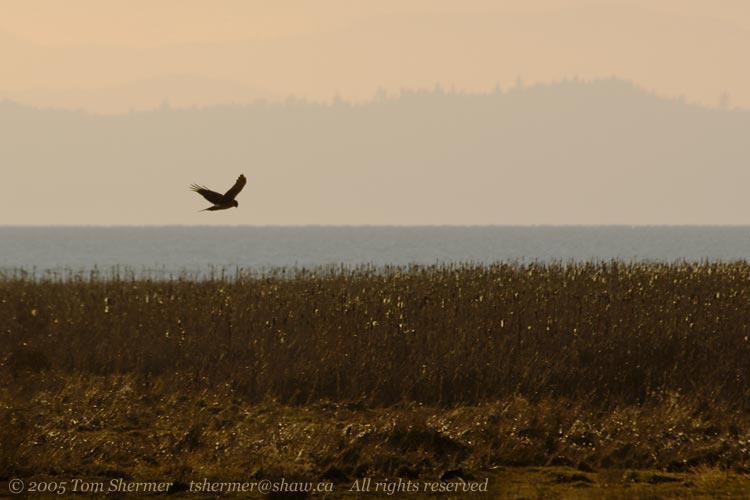 |
| A flight
of five trumpeter swans flew by, their bodies looking golden in
the late afternoon sun. |
|
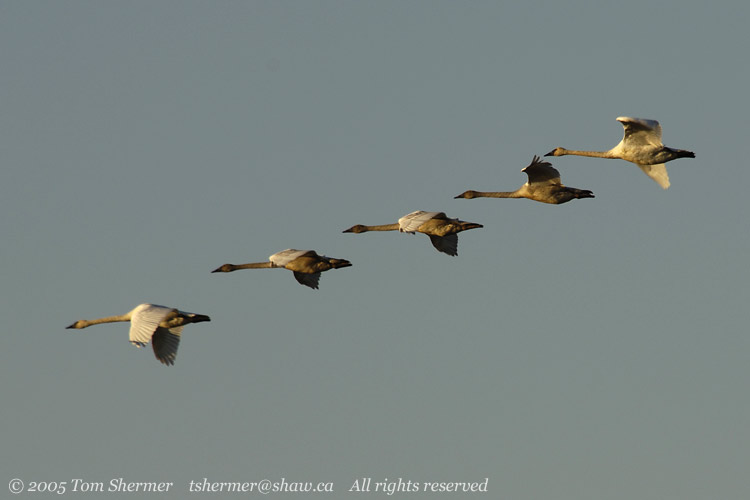 |
| Once I found
a Snowy Owl on a nice perch, I headed out towards it, going along
a little path on the foreshore. I stopped when I found a few sparrows
flitting around out there. It took a little while, but I finally
determined that some weret Song Sparrows, and some were White-crowned.
Here's a sharp-looking Song. |
|
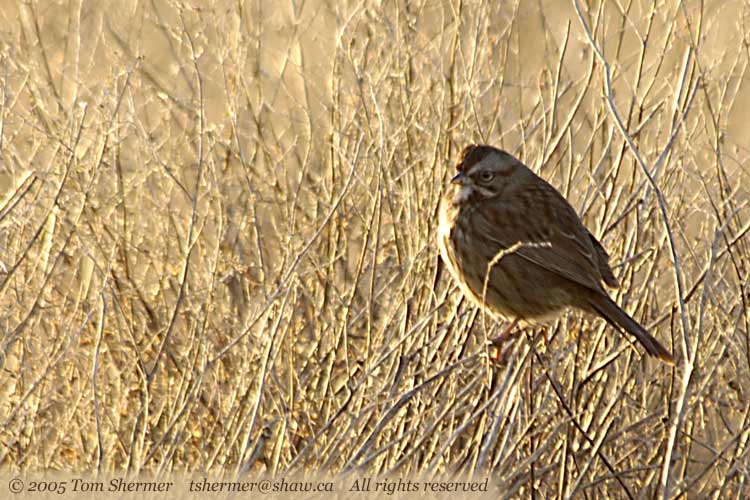 |
| And here's
an adult White-crowned. This fellow has a fairly interesting white
chin, which isn't something I've particularly noticed on White-crowneds
before. |
|
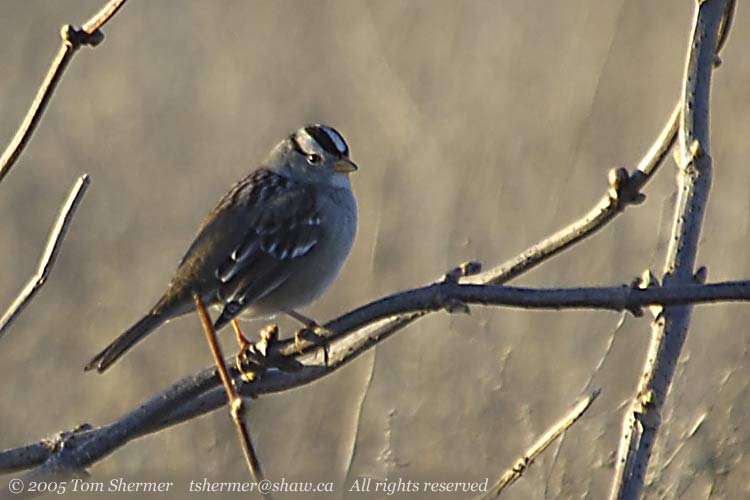 |
| The Snowy
Owl that I had spotted had taken off while I was engrossed with
the sparrows, but luckily, he came back and landed on the same perch. |
|
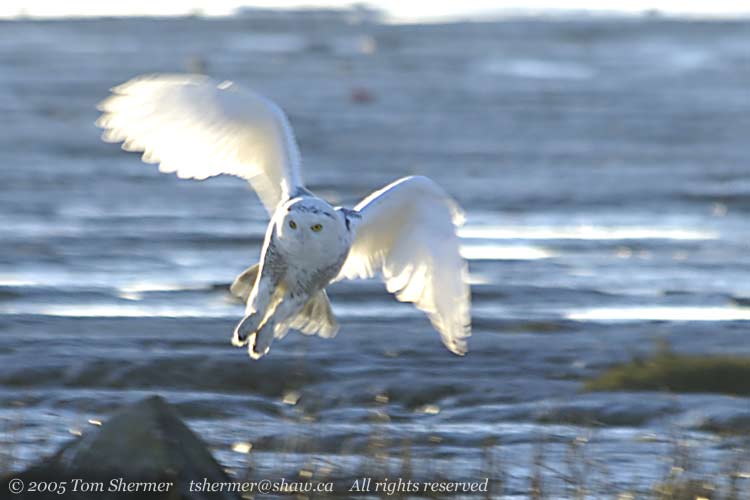 |
| I managed
to get a little closer while he rested for a bit, thanks partly
to a good pair of hiking boots. It was wet and muddy and partly
icy out there. |
|
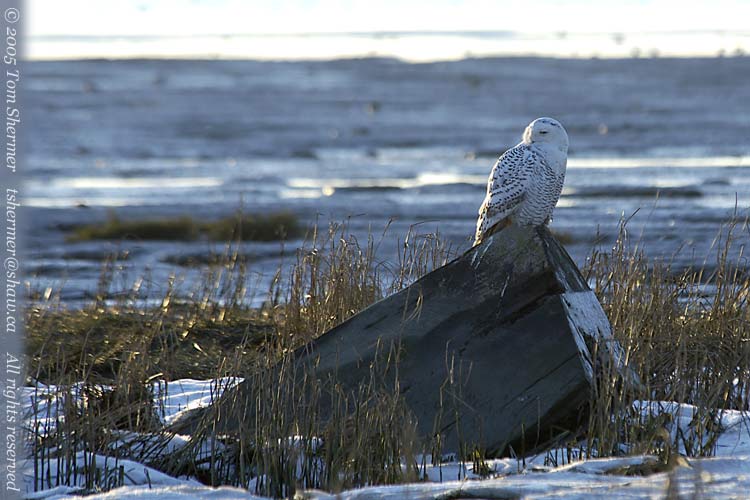 |
|
Some hunters on the
foreshore behind me shot at something, and it seemed quite loud
and near. It made me jump a little and it really spooked the owl.
Whereas before he had been ignoring me, he now became quite wary
and I wasn't able to advance any closer. There's no way I would've
gotten as close as I was if the shot had occurred earlier.
So I contented myself
with the viewpoint I had, and took a few more photos as the sun
was really starting to go down. Here I caught him watching another
bird fly by.
|
|
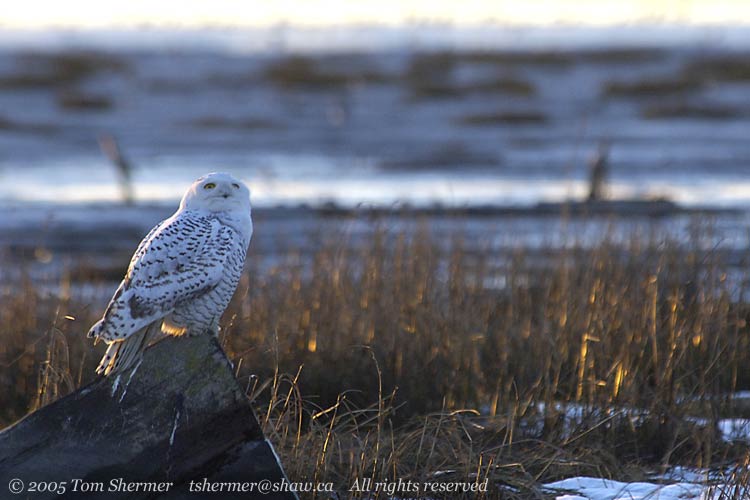 |
|
Eventually, the owl's
attention turned to something further along the foreshore, and
after peering in that direction for a while, he flew over to investigate.
I took that opportunity to retreat from the icy mud I was on back
to the main trail. I got a few more shots of him at his new perch
on the foreshore, but the earlier shots were better.
He then flew off from
this perch, to somewhere far on the foreshore where I lost sight
of him. As the sun was almost gone now, and it was getting quite
chilly, I headed back towards my car.
I encountered the owl
once more, though. Or at least, I encountered a Snowy Owl; I think
it was the same one, but I'm not certain. This owl was perched
in the top of a tree by the path. This was interesting for me
because I've always seen them on low perches (logs or rocks on
the foreshore, mainly), but apparently up north they're known
for perching on power poles and other high up places like this.
Anyhow, he presented
an excellent opportunity for a very Vancouver photo: a snowy owl
with (Grouse Mountain?) ski slopes in the background. I took this
shot at around 4:30, which was after the sun went down. This meant
that it was a moderately long exposure (1/6 of a second), so it's
a good thing that owl wasn't moving much.
|
|
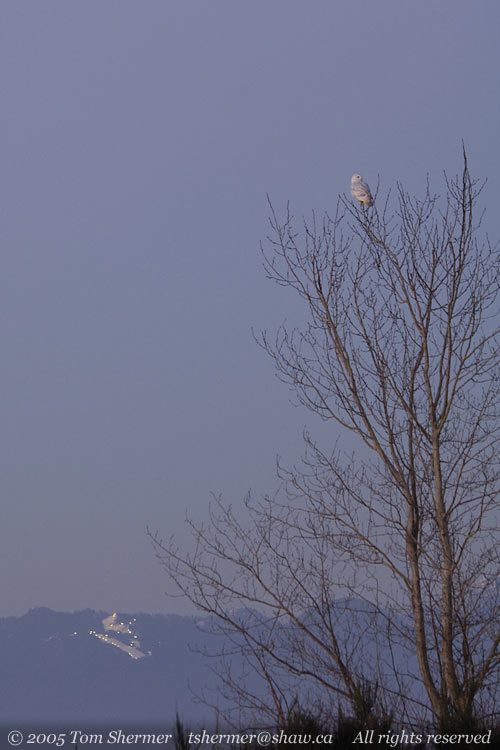 |
|
That ended a chilly,
all-too-short, but otherwise very nice day that held my lifer
American Avocet and some quality time with a Snowy Owl
Dreaming of long summer
days,
Tom
|
|
|